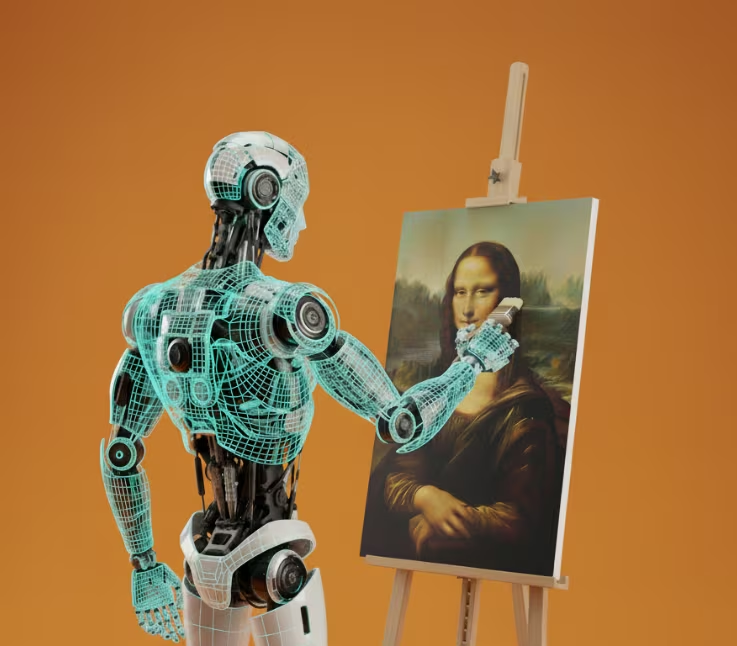- What Is Generative AI, Really?
- Types of Generative AI
- How Does Generative AI Work?
- Popular AI Generators You Should Know
- Examples of Generative AI in Action
- A Brief History of Generative AI
- What Are the Applications of Generative AI Today?
- Benefits of Generative AI?
- What Are the Risks and Ethical Concerns of Generative AI?
- Where Is Generative AI Going?
Generative AI is a type of artificial intelligence that creates new content like text, images, code, or audio based on patterns it has learned from existing data. It’s rapidly gaining attention for transforming how people work, communicate, and build creative and technical projects.
As Sam Altman, CEO of OpenAI, says: “AI will continue to get way more capable … People are using it to create amazing things. If we could see what each of us can do 10 or 20 years in the future, it would astonish us today.”
The buzz began when tools like ChatGPT and DALL·E showed that AI could write essays, generate images from text prompts, and even compose music or write software. What felt like science fiction just a few years ago is now embedded in everyday apps, workplaces, and workflows. Businesses are investing billions in this technology, and users are finding both productivity gains and new ethical questions to navigate.
But despite the headlines, most people still ask: “What exactly is generative AI, how does it work, and what does it mean for me?”
What Is Generative AI, Really?
Generative AI is a branch of artificial intelligence designed to create original content like text, images, audio, code, or video by learning patterns in large datasets. Unlike traditional AI, which classifies or predicts based on existing inputs, generative AI produces entirely new outputs that resemble real human creations.
At its core, generative AI answers a different question than most machine learning models. Instead of asking, “What is this?” (classification) or “What happens next?” (prediction), it asks, “What could be?” The model learns the structure of data language rules, visual patterns, or coding logic and generates something new that statistically fits.
How Generative AI Differs from Traditional AI
Traditional AI is great at recognizing patterns and making decisions based on existing data. It’s often used for tasks like detecting spam emails, forecasting trends, or automating simple processes.
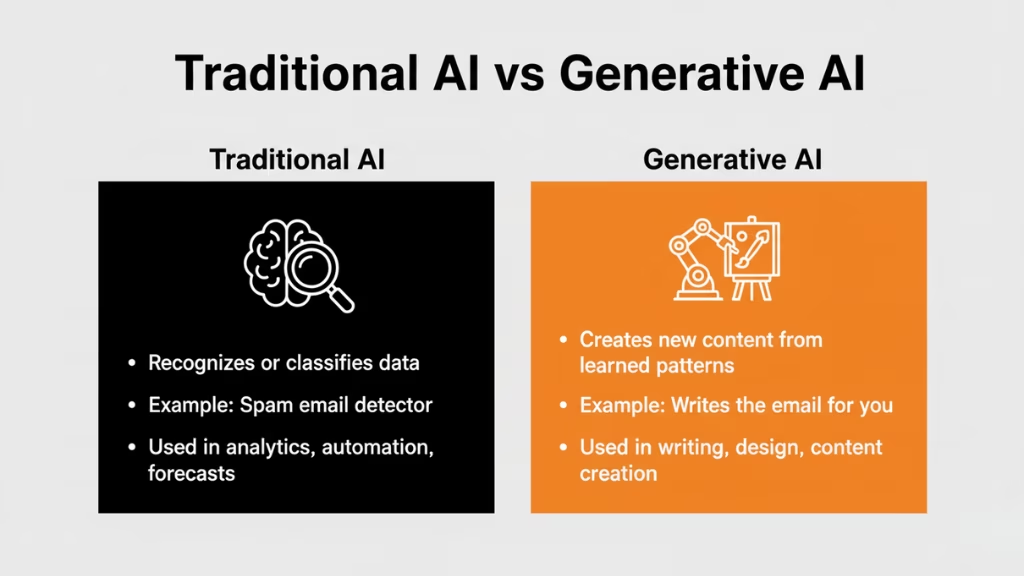
In these cases, the AI looks at what’s already there and decides what category it fits into or what might happen next.
Generative AI works differently. Instead of just analyzing data, it creates something entirely new from what it has learned. For example, while a traditional AI might filter out spam, a generative AI can actually write the email for you. It’s used in writing, designing, coding, and other creative tasks where the goal is to produce original content — not just interpret existing information.
Learning Distributions
Generative models work by estimating the probability distribution of the training data. This allows them to generate content that looks, sounds, or behaves like the original data but is entirely new.
For example:
- A generative text model like GPT-4 might complete a sentence or write an article from scratch.
- An image model like DALL·E or Stable Diffusion can turn a sentence like “a futuristic city at sunset” into a unique image.
Where You’ve Already Seen It
You’ve likely interacted with generative AI already:
- Chatbots that answer in full paragraphs
- AI tools that generate illustrations or social posts
- Code assistants that complete functions automatically
The shift is profound: AI is moving from reactive tools to creative collaborators.
Types of Generative AI
Generative AI is powered by diverse model architectures — each with distinct learning strategies, capabilities, and use cases. From image synthesis to code generation, these models underpin today’s most advanced applications across language, vision, audio, and structured data.
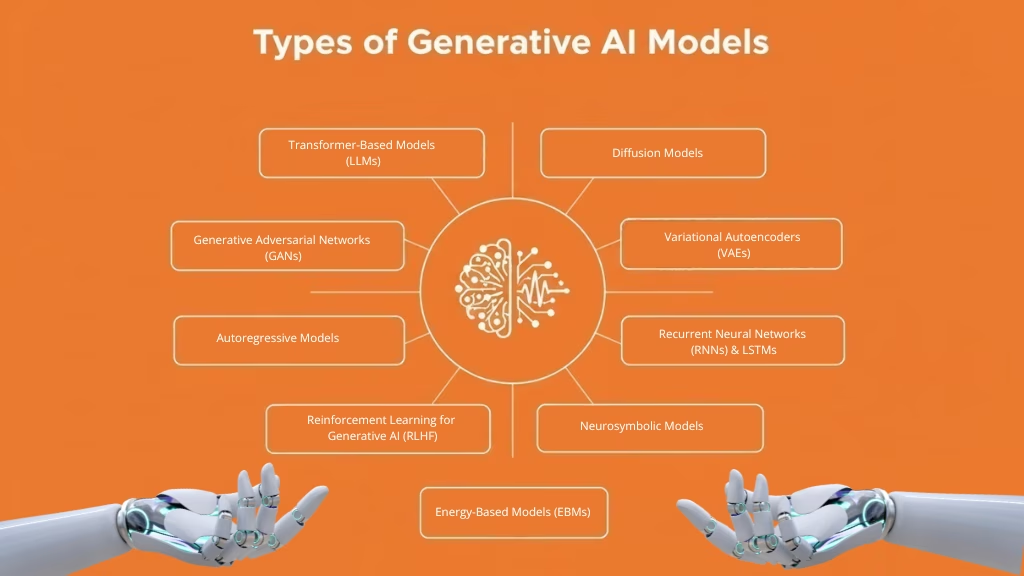
1. Transformer-Based Models (LLMs)
Use Case: Language generation, code, vision-language models
Key Examples: GPT-4, Claude, Gemini, BERT (understanding), DALL·E (vision)
Transformers are the foundation of modern generative AI, particularly in natural language processing. Introduced by Vaswani et al. in 2017, they use a self-attention mechanism to evaluate relationships between all parts of an input sequence in parallel — allowing for deep context awareness and scalability.
- Architecture: Encoder-decoder or decoder-only (e.g., GPT); uses multi-head self-attention layers
- Strengths: Highly parallelizable, excellent scalability with data/compute, cross-modal adaptability
- Applications: Chatbots, text generation, translation, summarization, code generation, text-to-image
2. Generative Adversarial Networks (GANs)
Use Case: Image and video synthesis, style transfer, synthetic data
Key Examples: StyleGAN, BigGAN, ThisPersonDoesNotExist.com
GANs operate via a two-network game between a generator (produces synthetic samples) and a discriminator (judges authenticity). The competition drives both networks to improve, resulting in highly realistic outputs.
- Architecture: Generator + Discriminator trained adversarially
- Strengths: Sharp, photorealistic image outputs; excellent for creativity
- Applications: AI art, synthetic faces, upscaling, deepfakes, super-resolution
3. Diffusion Models
Use Case: Text-to-image generation, photo editing, audio synthesis
Key Examples: Stable Diffusion, DALL·E 2, Google Imagen, Sora
Inspired by thermodynamic diffusion, these models add noise to data over multiple steps and then learn to reverse that noise process to generate clean outputs. They now outperform GANs in image fidelity and diversity.
- Architecture: Forward (noising) and reverse (denoising) stochastic processes
- Strengths: Stable training, high-quality samples, robust to mode collapse
- Applications: Image generation from text, inpainting, video creation, molecule generation
4. Variational Autoencoders (VAEs)
Use Case: Data variation, anomaly detection, compressed latent modeling
Key Examples: β-VAE, VQ-VAE, NVAE
VAEs encode input data into a probabilistic latent space and decode from it to reconstruct new samples. This structure enables smooth interpolation and controlled generation, though outputs are typically less sharp than GANs.
- Architecture: Encoder → Latent Distribution → Decoder
- Strengths: Interpretability, smooth latent space, probabilistic sampling
- Applications: Anomaly detection, generative design, style variation, unsupervised learning
5. Autoregressive Models
Use Case: Text, time series, image and audio sequence modeling
Key Examples: GPT-2/3/4 (text), PixelRNN/CNN (images), WaveNet (audio)
These models predict the next token or element one step at a time, conditioned on previous outputs. They are powerful for sequence generation and modeling complex dependencies but slower in inference due to stepwise decoding.
- Architecture: Sequential generation via next-token prediction
- Strengths: High fidelity, strong local coherence
- Applications: Story and code writing, stock price forecasting, pixel-level image creation
6. Recurrent Neural Networks (RNNs) & LSTMs
Use Case: Sequential data, speech synthesis, music generation
Key Examples: LSTM, GRU, DeepSpeech, early chatbot architectures
RNNs process input data step-by-step while maintaining memory of prior inputs. LSTMs and GRUs improve upon standard RNNs by addressing the vanishing gradient problem, enabling learning over long sequences.
- Architecture: Cyclic hidden state with gates (LSTM)
- Strengths: Effective for temporal data and sequence dependency
- Applications: Speech recognition, real-time translation, predictive typing, melody generation
7. Reinforcement Learning for Generative AI (RLHF)
Use Case: Alignment, dialog optimization, creative generation
Key Examples: ChatGPT (fine-tuned via RLHF), reward-model-tuned assistants
Reinforcement Learning is used to align generative models with human goals. In RLHF (Reinforcement Learning from Human Feedback), a reward model is trained from human preferences and guides further fine-tuning of the base model.
- Architecture: Policy model + reward model + optimizer
- Strengths: Human-aligned outputs, better safety and relevance
- Applications: Safer chatbots, controllable generation, dialog systems, game level generation
8. Other Emerging Architectures
Normalizing Flows: Learn invertible mappings between data and latent spaces; ideal for exact likelihood estimation
Energy-Based Models (EBMs): Score data using an energy function; still experimental but conceptually powerful
Neurosymbolic Models: Combine deep learning with symbolic logic; promising for explainability and structured reasoning
How Does Generative AI Work?
Generative AI works by training deep learning models to understand patterns in large datasets and then using those patterns to generate new, similar content. These models learn not just to memorize data, but to model the underlying structure of it, whether it’s language, images, or code.
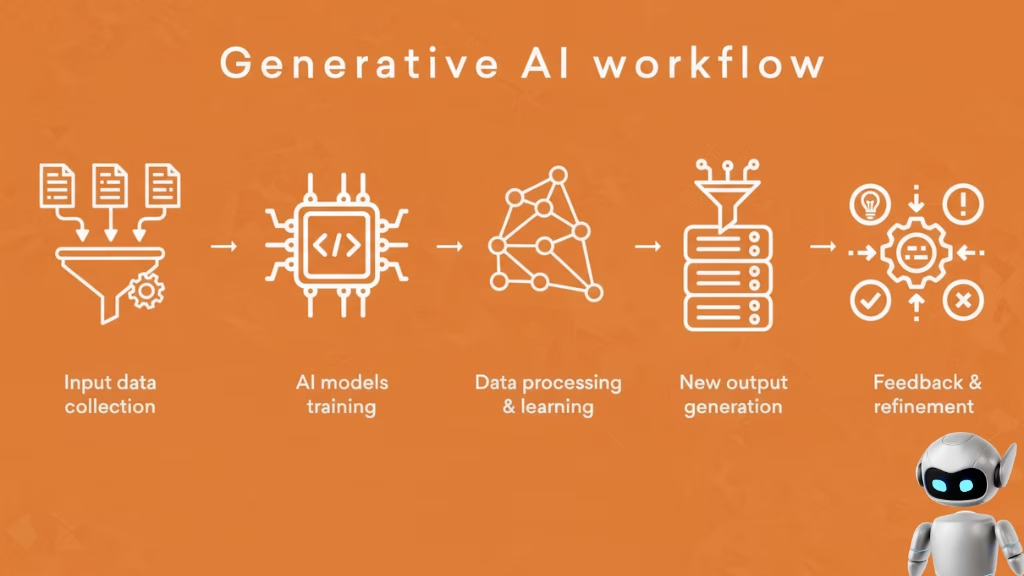
At a high level, generative AI involves two main phases:
1. Training the Model
During training, a model processes massive amounts of data for example, billions of words or images. It learns the relationships, sequences, and probabilities within that data. This phase is typically self-supervised, meaning the model teaches itself without needing labeled examples.
- Language Models learn to predict the next word in a sentence.
- Image Models learn to reconstruct or generate images from noise or prompts.
- Code Models learn the syntax and logic of programming languages.
Training involves optimizing a mathematical function (called a loss function) using techniques like backpropagation and gradient descent. These help the model adjust millions sometimes billions of internal parameters to minimize errors.
2. Generating Content (Inference Phase)
Once trained, the model can generate new content by sampling from the patterns it has learned.
- In language generation, the model predicts the most likely next word, token by token.
- In image generation, it may start with random noise and “denoise” it step by step to create a coherent image.
- In code generation, it interprets a natural-language prompt and produces functional code.
Techniques like temperature sampling, beam search, and top-k/nucleus sampling control how deterministic or creative the output is.
These architectures will be explored more deeply in the next section.
Popular AI Generators You Should Know
Generative AI platforms make it easier for individuals and teams to automate content creation, design, coding, and communication tasks. Below are some of the most widely used tools, each specializing in different types of creative output.
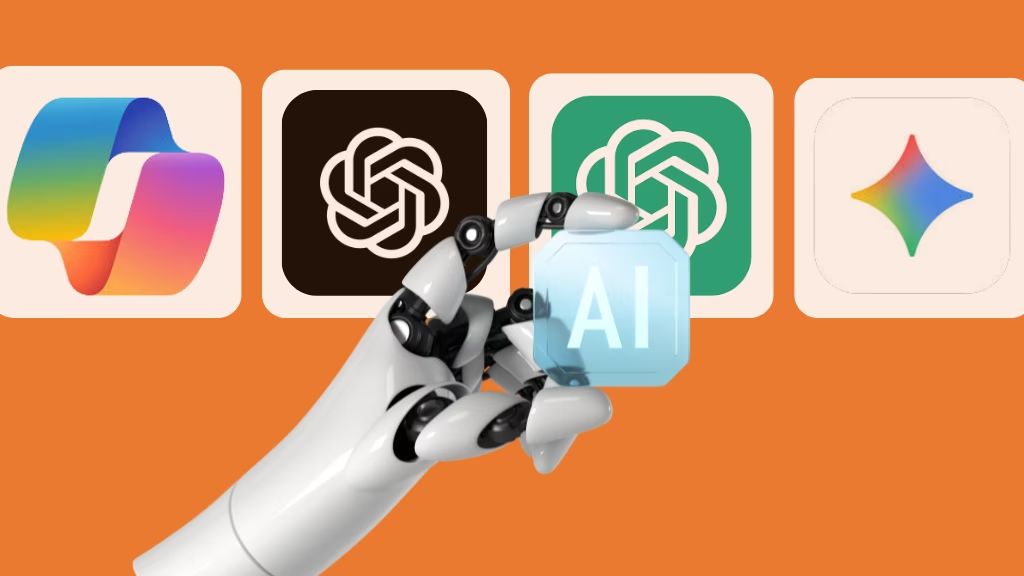
ChatGPT (OpenAI)
Best for: Writing, research, and ideation
Built on the GPT (Generative Pre-Trained Transformer) architecture, ChatGPT generates human-like text responses for research, strategy, writing, and communication. It can draft emails, reports, lesson plans, and even technical documentation making it a go-to assistant for professionals and students alike.
DALL·E 3 (OpenAI)
Best for: Image creation and concept visualization
DALL·E 3 turns written prompts into vivid, detailed images. Designers, marketers, and educators use it to create illustrations, product mockups, and visual storytelling assets that complement written content.
Microsoft Copilot
Best for: Productivity and workflow automation
Integrated across Microsoft 365 (Word, Excel, PowerPoint, Outlook), Copilot uses OpenAI’s models to assist with document drafting, spreadsheet analysis, and presentation design. It’s also available as a stand-alone product, blending generative text with real-time business data.
Google Gemini (formerly Bard)
Best for: Research and creative collaboration
Gemini is Google’s multimodal AI model integrated across its ecosystem including Docs, Sheets, and Gmail. It combines text generation with image understanding, helping users brainstorm, summarize, and organize information interactively.
Each of these platforms demonstrates how generative AI can streamline daily workflows from content and design to productivity and strategy all with a few natural-language prompts.
Examples of Generative AI in Action
Generative AI has become a practical co-creator across creative, academic, and business contexts. These examples illustrate how users apply GenAI tools to boost productivity and creativity in real-world scenarios.
Content Writing and Editing
- Generate blog posts, ad copy, or essays in specific tones and lengths
- Rewrite or summarize text for clarity and conciseness
- Create outlines for research papers, resumes, and marketing briefs
Example: Using ChatGPT to produce a first draft of a report or social media post, which you then refine manually.
Multimedia and Localization
- Add subtitles or dubbed audio to educational videos, films, and tutorials
- Generate voiceovers or translations for international audiences
- Enhance learning accessibility through automated captioning
Example: An e-learning company using AI dubbing tools to translate training materials into multiple languages.
Programming and Technical Tasks
- Generate simple code snippets or starter frameworks
- Improve existing code through optimization and debugging suggestions
- Automate repetitive tasks such as documentation or test case generation
Example: Developers using GitHub Copilot to complete code faster and reduce manual workload.
Music, Design, and Creative Production
- Compose melodies or instrumentals in specific genres or moods
- Generate album art, logos, or promotional graphics from prompts
- Combine text, audio, and visuals for integrated media projects
Example: Artists using DALL·E or Midjourney to design visuals inspired by AI-composed tracks.
Summarization and Knowledge Work
- Condense long articles, emails, or meeting transcripts
- Generate executive summaries or key-point digests
- Draft survey forms, presentation outlines, or project briefs
Example: Teams using AI to create structured summaries from raw meeting notes or documents.
Generative AI accelerates creative and analytical tasks alike helping professionals move from idea to output faster. However, as adoption grows, the need for responsible regulation and human oversight becomes increasingly critical to ensure accuracy, fairness, and authenticity.
A Brief History of Generative AI
Generative AI has evolved from simple rule-based systems to powerful models capable of producing human-like text, images, and audio. Its development has followed major breakthroughs in deep learning, model architectures, and computing power.
Here’s a high-level timeline of key milestones:
1960s–1980s: Early Generative Attempts
ELIZA (1966): A rule-based chatbot that mimicked conversation using scripts not truly generative, but a precursor to AI dialogue.
Markov Chains: Used in simple text generation (e.g., random sentence assembly based on word probabilities).
2014: The Rise of Deep Generative Models
Generative Adversarial Networks (GANs) were introduced by Ian Goodfellow.
- Revolutionized image synthesis by allowing machines to generate highly realistic visuals.
- Set the stage for creative AI applications in art, gaming, and synthetic media.
2017: Transformers Change the Game
- “Attention Is All You Need” (Vaswani et al.): Introduced the transformer architecture.
- Enabled better understanding of context in sequences, the foundation of modern language models.
2018–2020: Scaling Language Models
- OpenAI GPT-1, GPT-2, GPT-3: Marked the start of massive pretrained models trained on internet-scale text.
- BERT (Google): Focused on understanding language rather than generating it used for search and NLP tasks.
2021–2022: Multimodal and Diffusion Models Emerge
- DALL·E & CLIP (OpenAI): Combined vision and language to generate images from text prompts.
- Diffusion Models (e.g., Stable Diffusion, Imagen): Outperformed GANs in image quality and control.
- Whisper (OpenAI): A generative model for speech recognition and translation.
2023–2025: The Generative AI Explosion
- ChatGPT becomes mainstream (2022): Millions adopt generative tools in work and education.
- GPT-4, Claude, Gemini, LLaMA 2/3: More powerful, multimodal models capable of text, image, code, and voice generation.
- Enterprise & open-source adoption: AI assistants, copilots, and sandbox models enter every major platform.
Each wave of innovation from GANs to Transformers to Diffusion expanded what machines can create. Today’s generative AI is the result of over a decade of breakthroughs layered on one another.
What Are the Applications of Generative AI Today?
Generative AI is being used across industries to automate tasks, enhance creativity, and improve productivity. From writing marketing copy to designing new products, it enables machines to create content that once required human imagination and labor.
“AI will bring a lot of benefits to the world … but we must ensure it benefits everyone.” – Yann LeCu
Below are key application areas, with real-world examples:
1. Content & Communication
Generative AI tools can draft, rewrite, or personalize language in various formats.
- Use Cases:
- Email writing
- Blog posts and SEO content
- Social media captions
- Chatbots and customer support
- Email writing
- Example Tools: Jasper, ChatGPT, Copy.ai
2. Visual Creation & Design
AI can produce high-quality images, designs, and illustrations from text prompts or sketches.
- Use Cases:
- Product mockups
- Ad creatives and graphics
- Book covers and concept art
- Game and film visual design
- Product mockups
- Example Tools: Midjourney, DALL·E, Canva AI
3. Audio, Music & Voice
Generative models can compose music or synthesize human-like speech.
- Use Cases:
- Podcast intros
- Voice assistants and dubbing
- AI-generated jingles or beats
- Language learning tools
- Podcast intros
- Example Tools: ElevenLabs, Aiva, Google’s MusicLM
4. Programming & Software Development
AI can write and debug code, suggest functions, or generate full apps from prompts.
- Use Cases:
- Autocomplete for developers
- Code translation and refactoring
- Building no-code tools from descriptions
- Autocomplete for developers
- Example Tools: GitHub Copilot, Replit Ghostwriter
5. Industry-Specific Applications
- Healthcare:
- Synthesizing patient data for simulations
- AI-generated radiology reports
- Drug discovery (e.g., generating molecular structures)
- Synthesizing patient data for simulations
- Finance:
- Report summarization
- Risk modeling using synthetic data
- Fraud scenario simulation
- Report summarization
- Education:
- Personalized learning content
- Automatic test creation
- Essay feedback tools
- Personalized learning content
6. Simulation, Gaming & Virtual Worlds
- Dynamic storyline generation
- NPC dialogue scripting
- Procedural world building
- Voice-driven character interaction
Business Value Snapshot:
| Application | Value Delivered |
|---|---|
| Marketing copy generation | Speed + personalization |
| AI customer support | 24/7 availability with natural conversation |
| AI image generation | Rapid visual content at low cost |
| Code assistants | Faster development cycles |
| Synthetic training data | Reduced privacy risk, more model accuracy |
Generative AI is not just hype it’s already embedded in business tools, creative workflows, and professional services. As capabilities expand, its use cases will become even more dynamic and tailored.
Benefits of Generative AI
Generative AI delivers value by boosting creativity, increasing efficiency, and enabling personalization at scale. It helps individuals and organizations produce high-quality content faster often with fewer resources and opens up new ways of solving problems.
Here are the most impactful advantages:
1. Faster Content Creation
- Automates writing, design, and coding tasks that would otherwise take hours or days
- Great for marketers, writers, developers, and educators
- Example: Generating a product description in seconds instead of manually writing one
2. Enhanced Creativity & Ideation
- Sparks new ideas or variations (e.g., multiple image styles or blog openings)
- Works well for brainstorming, prototyping, or exploring concepts
- Helps overcome creative blocks by offering AI-generated inspiration
3. Personalization at Scale
- Tailors messaging, visuals, or product recommendations based on user data
- Enables dynamic content for different audiences or segments
- Common in email marketing, online learning, and customer engagement
4. Increased Productivity
- Supports professionals with AI copilots or assistants
- Automates routine or repetitive tasks (e.g., summarizing meeting notes, rephrasing emails)
- Lets teams focus on higher-level thinking and decision-making
5. Cost Efficiency
- Reduces dependency on outsourced creative services or manual labor
- Enables startups and small teams to produce enterprise-level outputs
- Cuts down on revision cycles by offering multiple drafts instantly
6. Democratization of Skills
- Empowers non-experts to create in areas like design, writing, and coding
- Makes complex technologies more accessible to educators, students, and creators
- Lowers the barrier to entry across industries
7. Strategic Differentiation for Businesses
- Creates unique brand experiences (e.g., AI-powered virtual advisors)
- Drives innovation in customer interaction and product development
- Supports data-driven experimentation (e.g., testing thousands of ad variations)
Generative AI isn’t just about speed; it’s about scaling intelligence, creativity, and personalization in ways that weren’t possible before.
What Are the Risks and Ethical Concerns of Generative AI?
While generative AI brings innovation and efficiency, it also raises serious concerns around accuracy, misuse, ethics, and sustainability. The risks span from misinformation and copyright disputes to energy demands and new security threats. Understanding these issues is crucial for adopting AI responsibly.
1. Misinformation, Hallucination & Deepfakes
Generative AI tools can “hallucinate,” producing outputs that sound factual but are entirely fabricated.
These errors can have real-world consequences. For example, Air Canada was sued after its chatbot shared incorrect refund information.
Deepfake images and videos further blur truth boundaries, enabling disinformation or fraud.
Example: Fake videos of public figures or AI-generated news articles spreading false narratives.
2. Fake Citations & Academic Misuse
AI models can generate convincing but nonexistent references.
Several law firms have been penalized for submitting briefs containing fabricated legal citations.
A Stanford professor’s expert testimony was dismissed for including fake citations generated by ChatGPT, ironically, in a case about deepfakes.
Implication: Users must verify AI-generated research to maintain academic and professional integrity.
3. Bias, Discrimination & Fairness
AI models often absorb social and cultural biases from their training data.
Outputs can unintentionally reinforce stereotypes or exclusionary patterns.
For instance, AI-generated job ads or facial recognition systems may favor certain demographics.
Challenge: Ensuring fairness requires transparent datasets and continuous bias audits.
4. Copyright, IP & Terms of Service Violations
Copyright and data ownership laws have not yet caught up with generative AI.
Many models are trained on copyrighted works without explicit permission, raising questions about fair use and creative ownership.
In addition, some AI companies have been accused of violating publishers’ terms of service (TOS) during data scraping e.g., disputes between OpenAI, Microsoft, and The New York Times.
Risk: Enterprises using these models could face legal exposure even when using “open” models.
5. Openwashing & Lack of Transparency
Some AI providers claim to offer “open” models but impose hidden restrictions.
Licensing terms may include fees after certain usage thresholds or restrict commercial competition.
Many “open” models also fail to disclose their training data, limiting transparency and making bias detection harder.
Takeaway: True openness requires full disclosure of data sources and licensing clarity.
6. Data Sweatshops & Human Exploitation
Behind AI’s automation lies human labor.
Many datasets are annotated by low-wage workers in developing countries, sometimes exposed to graphic or distressing content without adequate protection.
These “data sweatshops” raise ethical and mental health concerns.
Impact: The hidden human cost of training AI models must be acknowledged and regulated.
7. Environmental & Energy Impact
Training large AI models consumes significant energy and water resources.
Mega data centers powering generative AI strain electrical grids and raise local utility rates.
The carbon footprint of large-scale AI infrastructure has become a growing environmental concern.
Example: GPT-3’s training reportedly used hundreds of megawatt-hours of energy.
8. New Security Threats & Cyber Risks
Generative AI can inadvertently empower attackers.
Models can help craft sophisticated phishing emails, fake voices, or deepfake videos mimicking trusted executives.
On a technical level, AI systems can identify vulnerabilities faster than traditional methods making defensive cybersecurity more complex.
Result: Enterprises must strengthen verification and authentication systems to counter AI-enabled threats.
9. Loss of Human Oversight & Over-Reliance
Overconfidence in AI outputs can lead to poor judgment or costly mistakes.
Users might skip verification steps or defer too much decision-making to AI.
In sensitive fields like law, healthcare, or finance, unchecked AI outputs can lead to real-world harm.
Solution: Keep human review at the center of all generative AI workflows.
10. Regulatory and Ethical Uncertainty
Governments worldwide are racing to establish AI governance standards.
Emerging regulations like the EU AI Act and proposed U.S. AI Bill of Rights focus on transparency, explainability, and accountability.
AI watermarking and labeling initiatives aim to make synthetic content traceable.
Challenge: Organizations must stay agile as laws evolve to ensure compliance and ethical alignment.
Generative AI must be developed and deployed responsibly with transparency, fairness, and human oversight.
Its promise is immense, but so are its pitfalls. Addressing issues like misinformation, bias, copyright, data ethics, and sustainability will determine whether AI becomes a tool for progress or a source of disruption.
Where Is Generative AI Going?
Generative AI is evolving rapidly from powering chatbots and image tools to shaping the future of multimodal interfaces, responsible AI, and real-time personalization. As models get faster, more flexible, and better regulated, their role in everyday life will deepen.
“This is going to impact every product across every company.” – Sundar Pichai, Google
Here’s where the field is headed:
1. Multimodal AI: Beyond Just Text or Images
- Models are now trained to handle multiple data types at once: text, image, audio, and video.
- Multimodal systems allow users to upload an image and ask questions about it, or generate code from a voice command.
Emerging Examples:
- OpenAI’s GPT-4 with image input
- Google Gemini is integrating voice, vision, and text
- AI tools that take a photo and suggest edits, captions, or responses
2. Memory-Enhanced and Agentic Systems
- Newer generative systems can remember past interactions, goals, or user preferences over time.
- This leads to more helpful AI “agents” not just tools, but assistants that can reason and act.
Use Cases:
- Personal tutoring
- Executive support
- Task planning and automation
3. Smaller, More Efficient Models
- Instead of relying on massive centralized models, lightweight “edge” AI will run on local devices.
- Open-source alternatives (e.g., LLaMA 3, Mistral) are gaining traction for private or offline use.
Impact:
- Faster response times
- Lower cost and energy use
- More secure data handling
4. Responsible AI: Ethics, Safety & Governance
- Governments and companies are developing policies around bias testing, transparency, and auditability.
- Tools for watermarking AI content, identifying hallucinations, and improving explainability are in active development.
Key Developments:
- EU AI Act (2024–2025)
- Industry-wide pushes for AI labeling, consent mechanisms, and ethical training standards
5. Embedded AI in Everyday Tools
- Generative AI will increasingly be built into productivity suites, operating systems, and physical devices.
- “Invisible AI” will write emails, summarize docs, translate meetings, or generate visual assets without explicit prompts.
Examples:
- Microsoft Copilot in Office
- Adobe Firefly in Photoshop
- Generative tools in CRM, HR, and design platforms
What to Expect Next:
- Greater control: Users will guide tone, format, and creativity level.
- More collaboration: AI tools will “co-create” instead of just generating output.
- Real-time intelligence: AI will respond dynamically to user goals, not just static prompts.
Generative AI is shifting from tool to teammate not just producing content, but understanding context and goals.
Generative AI Is Redefining Creation and Intelligence
Generative AI is not a passing trend; it’s a foundational shift in how we produce, personalize, and interact with information. From language and images to code and music, this technology allows machines to generate content that feels remarkably human.
In this guide, we’ve covered:
- What generative AI is and how it differs from traditional AI
- The core models and technologies behind it (transformers, GANs, diffusion)
- Key applications across industries like marketing, healthcare, and software
- The advantages it offers in speed, creativity, and personalization
- The risks around misinformation, bias, IP, and oversight
- What’s coming next from multimodal tools to agentic AI
Whether you’re a curious learner, business decision-maker, or developer, understanding generative AI is now essential. It will continue to shape how we work, create, and communicate raising new opportunities and new responsibilities.
FAQs: Common Questions About Generative AI
What is generative AI in simple terms?
Generative AI is a type of artificial intelligence that creates new content like text, images, or code by learning from existing data. It generates original outputs rather than just analyzing or categorizing inputs.
How is generative AI different from traditional AI?
Traditional AI focuses on predictions or classifications (e.g., spam detection), while generative AI produces new content (e.g., writing an email or generating an image) based on learned patterns.
What are examples of generative AI tools?
Popular tools include ChatGPT (text), DALL·E and Midjourney (images), GitHub Copilot (code), and ElevenLabs (voice). These tools turn user prompts into creative, usable outputs.
What types of content can generative AI create?
It can generate text (articles, emails), images (illustrations, designs), audio (music, speech), video, and even software code.
How does a transformer model work in generative AI?
Transformers use attention mechanisms to understand relationships between words or tokens in a sequence, enabling coherent text generation or translation.
What are GANs and how do they generate images?
GANs (Generative Adversarial Networks) pit two neural networks a generator and a discriminator against each other to create realistic-looking images.
Is generative AI safe to use?
It’s generally safe when used responsibly, but concerns include misinformation, bias, data privacy, and over-reliance. Human oversight is essential.
Who owns AI-generated content?
Ownership depends on local laws and the platform used. In many cases, AI-generated outputs may not be protected by copyright unless significantly modified by a human.
Can anyone use generative AI, or do you need technical skills?
Most generative AI tools are user-friendly and designed for non-technical users. However, deeper use (e.g., fine-tuning models) may require coding experience.
What’s the future of generative AI?
Generative AI is evolving toward multimodal interaction, smarter agents, and tighter ethical controls. It will become more personalized, explainable, and embedded in everyday tools.
This page was last edited on 16 October 2025, at 5:45 pm
How can we help you?
























